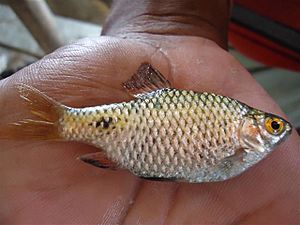Ticto barb facts for kids
Quick facts for kids Ticto barb |
|
|---|---|
 |
|
| Conservation status | |
| Scientific classification | |
| Synonyms | |
|
The ticto barb is a small, colorful freshwater fish. It is also called the twospot barb. This fish belongs to the Cyprinidae family, which includes carps and minnows.
You can find ticto barbs naturally in rivers and streams across many Asian countries. These include Nepal, India, Pakistan, Myanmar, Bangladesh, Thailand, and Sri Lanka. They live in places like the upper Mekong River and Irrawaddy River.
People sometimes confuse the ticto barb with the Odessa barb when buying fish for aquariums. However, male Odessa barbs have a bright reddish-orange color. Ticto barbs do not have this color.
The ticto barb is usually silver and gold. It has two black spots on its body. One spot is near its front fins, and the other is close to its tail. This fish can grow up to about 10 centimeters (4 inches) long.
Ticto barbs naturally live in warm, shallow waters. They prefer still areas of lakes and rivers. These places often have muddy bottoms. They like to search for food close to the bottom in shallow water. They live in a subtropical environment. They prefer water with a pH between 6.0 and 7.0. The water hardness should be up to 10 dGH. The temperature range they like is between 14 and 22 degrees Celsius (57-72 degrees Fahrenheit). Their diet includes small crustaceans, insects, and tiny plankton.
Scientists are still studying the ticto barb's classification. This is part of a process called taxonomic revision. It is often confused with a similar fish, P. stoliczkana. These two species live in the same areas.
Ticto Barbs in Aquariums
The ticto barb is an active fish that likes to live in groups. It is best to keep them in groups in an aquarium. When they are in large enough groups, they usually do not bother other types of fish. They prefer an aquarium with many plants. This setup is similar to their natural habitat of still, shallow waters with muddy bottoms.
Reproduction and Life Cycle
Ticto barbs lay eggs. They usually lay their eggs among coarse gravel. During spawning, a female ticto barb can lay about 150 eggs. She lays about 20 eggs at a time. After they finish laying eggs, the adult fish often try to eat them. Because of this, it is usually necessary to move the adult fish away from the eggs. This helps to protect the eggs from being eaten. The eggs will hatch in about one day. The baby fish will be able to swim freely about a day after hatching.
See also
- List of freshwater aquarium fish species


